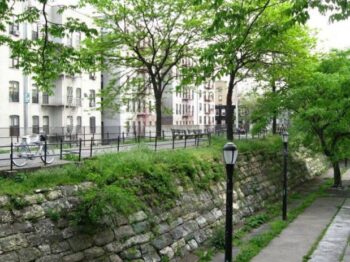
Old Croton Aqueduct Walk. Image Credit: LPC.
On August 15, 2023, the Landmarks Preservation Commission voted to calendar the Old Croton Aqueduct Walk for consideration as a scenic landmark. The Aqueduct Walk, located between the University Heights and Kingsbridge Heights sections of the Bronx, is a linear park along Aqueduct Avenue between West Kingsbridge Road and Burnside Avenue.
The walkway is atop of the Old Croton Aqueduct, constructed in 1842 and designed by David B. Douglass and John B. Jervis. The Aqueduct brought the first direct water supply to New York City. Its construction was preceded by a rapidly growing New York City in the 1830s that quickly depleted wells and cisterns. The limited immediate access to water created health and fire safety issues. In addition, outbreaks like the 1832 cholera outbreak showed the city’s need for a direct water source. In 1833, the Water Commission of New York decided to use the Croton River as a water source, but it would take nine years to develop the aqueduct and deliver the water to the city.
The aqueduct, completed in July 1842, is 41 miles long and carried 45 million gallons of water daily from a reservoir in Croton to New York City. The aqueduct sloped downwards allowing for gravity to deliver the water and saving the city from the expense of having to use hydraulic pumps. The conduit was covered with earth or stone walls, some of which are still visible at certain points.
The aqueduct was successful in providing the city with a source of direct water, but soon the old aqueduct could not keep up with the city’s growing demand for water. The New Croton Aqueduct was completed in 1890 and could carry three times as much water. The old aqueduct stayed in service along the new aqueduct until 1955. Afterward, New Yorkers still enjoyed the the path along the embankment. The community rallied together to preserve the aqueduct walkway and prevent a trolley from being constructed along the walkway in 1903, and again defended the walkway and prevented the land from being sold for development in 1929. In 1930, the Parks Department took control over the park.
The Parks Department has made several improvements to the land, including playgrounds, lighting, relief stations, and seating areas while also maintaining the historic integrity of the space. Landmarks continues to work with the Parks Department, who have been supportive of the designation.
The Landmarks Preservation Commission will hold a public hearing at a later date.
By: Veronica Rose (Veronica is the CityLaw fellow and a New York Law School graduate, Class of 2018.)

